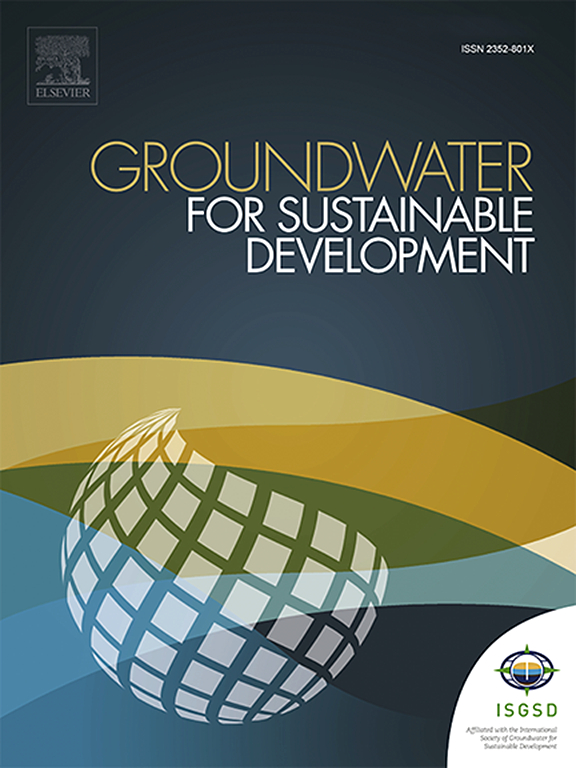Microbial transformation of upper aquifers loamy rocks under complex pollution during in situ bioremediation
IF 4.9
Q2 ENGINEERING, ENVIRONMENTAL
引用次数: 0
Abstract
The study investigated biogenic modifications in loamy rocks following a single stimulation of microbial activity in groundwater through the application of milk whey at a depth of 10–14 m in proximity to a radioactive waste storage facility, within a nitrate-polluted area near the Siberian Chemical Combine (Seversk, Tomsk Region). The consumption of nitrate ions and the establishment of anaerobic conditions via microbial denitrification were completed within 45 days of the in situ experiment. Milk whey served as an effective source of organic carbon (C), calcium (Ca), and phosphorus (P) for in situ bioremediation processes. Observed phenomena included the accumulation of carbonate minerals, reduction of iron and sulfate ions, and the formation of sulfide-iron phases. The release of iron from aluminosilicate mineral phases under anaerobic conditions resulted in partial mineral dissolution and the formation of amorphous silica. Subsequent phase analysis revealed the presence of crystalline iron sulfide forms, exhibiting compositional similarities to pyrrhotite and troilite. Laboratory experiments demonstrated that the absence of sulfate in the system led to a significant decrease in iron content within the solid phase, accompanied by a redistribution of remaining iron from silicate mineral matrices to amorphous phases associated with organic matter. Conversely, the presence of sulfate facilitated activity of sulfate-reducing bacteria and the accumulation of iron sulfide phases. The biogenic formation of authigenic mineral phases constitutes a critical factor in the development of a sedimentary mineral barrier, which is essential during complex groundwater contamination involving radionuclides and heavy metals.

复杂污染下上含水层壤土岩石原位修复过程中的微生物转化
该研究调查了在西伯利亚化学联合公司(托木斯克州塞维尔斯克)附近硝酸盐污染地区的放射性废物储存设施附近10-14米深的地方,通过使用乳清对地下水微生物活动进行一次刺激后,壤土岩石中的生物变化。在原位实验的45天内完成硝酸盐离子的消耗和微生物反硝化厌氧条件的建立。乳清是原位生物修复过程中有机碳(C)、钙(Ca)和磷(P)的有效来源。观察到的现象包括碳酸盐矿物的聚集,铁和硫酸盐离子的还原,硫化物-铁相的形成。在厌氧条件下,铁从铝硅酸盐矿物相中释放出来,导致部分矿物溶解,形成无定形二氧化硅。随后的物相分析揭示了结晶硫化铁形式的存在,表现出与磁黄铁矿和三黄铁矿相似的成分。实验室实验表明,系统中硫酸盐的缺失导致固相中铁含量显著下降,同时伴随着从硅酸盐矿物基质中剩余的铁重新分布到与有机质相关的无定形相中。相反,硫酸盐的存在促进了硫酸盐还原菌的活性和硫化铁相的积累。自生矿物相的生物成因形成是沉积矿物屏障发育的关键因素,在涉及放射性核素和重金属的复杂地下水污染中是必不可少的。
本文章由计算机程序翻译,如有差异,请以英文原文为准。
求助全文
约1分钟内获得全文
求助全文
来源期刊

Groundwater for Sustainable Development
Social Sciences-Geography, Planning and Development
CiteScore
11.50
自引率
10.20%
发文量
152
期刊介绍:
Groundwater for Sustainable Development is directed to different stakeholders and professionals, including government and non-governmental organizations, international funding agencies, universities, public water institutions, public health and other public/private sector professionals, and other relevant institutions. It is aimed at professionals, academics and students in the fields of disciplines such as: groundwater and its connection to surface hydrology and environment, soil sciences, engineering, ecology, microbiology, atmospheric sciences, analytical chemistry, hydro-engineering, water technology, environmental ethics, economics, public health, policy, as well as social sciences, legal disciplines, or any other area connected with water issues. The objectives of this journal are to facilitate: • The improvement of effective and sustainable management of water resources across the globe. • The improvement of human access to groundwater resources in adequate quantity and good quality. • The meeting of the increasing demand for drinking and irrigation water needed for food security to contribute to a social and economically sound human development. • The creation of a global inter- and multidisciplinary platform and forum to improve our understanding of groundwater resources and to advocate their effective and sustainable management and protection against contamination. • Interdisciplinary information exchange and to stimulate scientific research in the fields of groundwater related sciences and social and health sciences required to achieve the United Nations Millennium Development Goals for sustainable development.
 求助内容:
求助内容: 应助结果提醒方式:
应助结果提醒方式:


